Here's an Eight minute video on the benefits of #LionsMane #mushrooms by world renowned #mycelium expert, #PaulStamets
Source: https://youtube.com/watch?v=_Isphu4c8hU
One person like that
Here's an Eight minute video on the benefits of #LionsMane #mushrooms by world renowned #mycelium expert, #PaulStamets
Source: https://youtube.com/watch?v=_Isphu4c8hU
Aux Pays-Bas, un biodesigner a conçu un cercueil d'un nouveau genre appelé "Living Cocoon". Sa particularité : il est fabriqué à partir de champignons, plus exactement de mycélium. Une composition qui permettrait notamment au défunt de se décomposer plus rapidement.
Lutter contre les déchets, réduire sa consommation, limiter les transports polluants... A travers le monde, les citoyens sont de plus en plus nombreux à surveiller leur impact environnemental. De leur vivant. Mais qu'en est-il après la mort ? Les études demeurent rares. Pourtant, les diverses pratiques associées à la mort sont loin d'avoir un coût négligeable sur notre planète.
En 2017, les Services funéraires de la Ville de Paris ont publié une étude inédite sur l'empreinte environnementale des rites funéraires. Les résultats ont montré que l'inhumation équivalait à 11% des émissions d'un Français moyen en un an. Soit l'émission en moyenne de 430 kilogrammes de CO2. Du moins en fonction des "options" choisies.
Lieu d'inhumation, transport, composition du cercueil... Ces dernières années, diverses alternatives ont vu le jour pour rendre la fin de vie plus écologique. Aux Pays-Bas, c'est un cercueil d'un nouveau genre qui vient de sortir de l'imagination d'un biodesigner. Un cercueil "vivant" capable notamment d'accélérer la décomposition du défunt. Son nom : Living Cocoon (en français, "cocon vivant").
Nous sommes des nutriments, pas des déchets
"Le Living Cocoon permet aux gens de refaire corps avec la nature et d'enrichir le sol, plutôt que de le polluer", explique dans un communiqué Bob Hendrikx, créateur du cercueil et ancien étudiant de l'université de technologie de Delft. Le secret réside dans la composition du "cocon". Il est conçu à partir de champignons et plus exactement de mycélium, l'ensemble de filaments qui se trouve dans le sol.
Ce réseau souterrain est un "système de recyclage naturel", affirme le biodesigner de 26 ans. "Dans l'environnement, il cherche constamment des déchets à convertir en nutriments. Il fait de même avec les substances toxiques dont le pétrole, le plastique et le métal". Grâce au mycélium qu'il recèle, le cercueil vise ainsi à recréer le processus avec le corps des défunts.
Le mycélium est un "système de recyclage naturel" qui convertit les déchets en nutriments. Loop
L'objectif est "de nourrir la terre avec nos corps. Nous sommes des nutriments, pas des déchets", assure Bob Hendrikx. Dans un cercueil traditionnel, le corps humain peut mettre plus d'une décennie à se décomposer. La faute au bois vernis qui compose le coffre, au métal qui peut s'y trouver ou encore aux vêtements synthétiques qui ralentissent généralement le processus.
D'après son concepteur, le Living Cocoon serait capable d'accélérer considérablement le phénomène. Une fois mis en terre, le cercueil serait absorbé dans le sol en un mois à six semaines et contribuerait activement à décomposer le corps en deux à trois ans. En plus de convertir les déchets en nutriments, il permettrait également d'améliorer la qualité du sol environnant et de favoriser la pousse de jeunes plants.
Déjà en vente
Des tests pratiques ont déjà été menés par la firme américaine Ecovative, spécialisée dans les matériaux à base de mycélium, qui collabore avec la start-up Loop fondée par Bob Hendrikx. Les résultats ont montré que le cercueil se retrouve absorbé dans le sol en 30 à 45 jours dans les conditions rencontrées aux Pays-Bas. L'impact de l'invention sur le sol environnant reste cependant à évaluer plus précisément.
"Nous voulons savoir exactement quelle contribution cela apporte au sol parce que cela nous aidera à convaincre dans le futur les municipalités locales de transformer des zones polluées en zones boisées saines, en utilisant nos corps comme nutriments", souligne le biodesigneur dont le cercueil contient également une couche de mousse végétale qui contribue à la décomposition.
Bob Hendrikx aux côtés de son invention, le "premier cercueil vivant".
Après plusieurs mois d'expérimentation, les premières funérailles utilisant un Living Cocoon ont déjà eu lieu aux Pays-Bas, la semaine dernière. Et les "cocons" sont désormais disponibles à la vente en collaboration avec deux coopératives funéraires de La Hague, CUVO et De Laatste Eer, au prix de 2.000 euros pour les cent premiers selon le site officiel.
Bob Hendrikx espère toutefois réduire le coût en intensifiant la production des cercueils. Pour les concevoir, le mycélium doit être cultivé, sans utilisation d'électricité ni de lumière artificielle, pendant sept jours durant lesquels il adopte la forme du coffre. Ce dernier est ensuite séché naturellement, ce qui interrompt la croissance des filaments et permet de renforcer sa structure.
Si le concept du Living Cocoon est inédit, d'autres inventions funéraires à base de mycélium ont déjà vu le jour. En mai 2019, la fille de Luke Perry, acteur de la série Beverly Hills décédé à l'âge de 52 ans, a ainsi révélé que son père avait été enterré dans un "Infinity Burial Suit", un costume conçu par la firme Coeio contenant également du mycélium.
Bien que diverses alternatives existent à travers le monde, il est à noter que les rites funéraires restent très encadrés en France, y compris le choix du cercueil qui doit respecter certaines exigences en termes de solidité, d’étanchéité et de biodégradabilité notamment.
#Pays-Bas #environnement #champignons #mycelium #funéraire
L’article est paru sur Géo. Il y a 6 trackers sur l’article du site. Le lien est, à vos risques et périls : www.geo.fr/environnement/pays-bas-un-biodesigner-cree-un-cercueil-vivant-fabrique-a-partir-de-champignons-202097
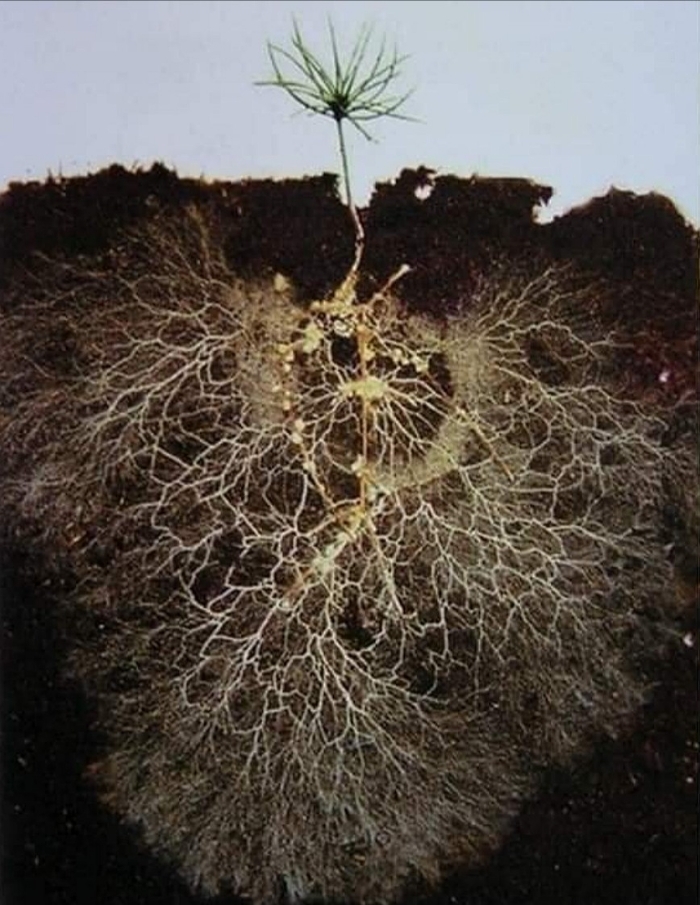
#pinetree #glassbox #mycorrhizal #mycelium#mushroom
A small pine tree in a glass box shows the level of white finally branched mycorrhizal threads or mycelium that attach to roots and feed the plant.
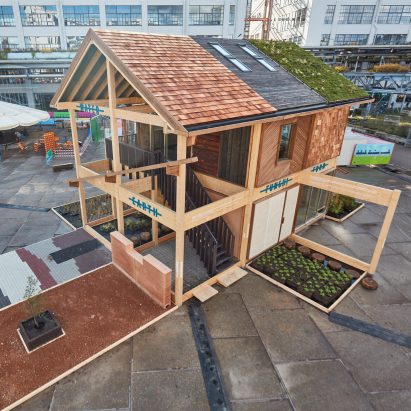
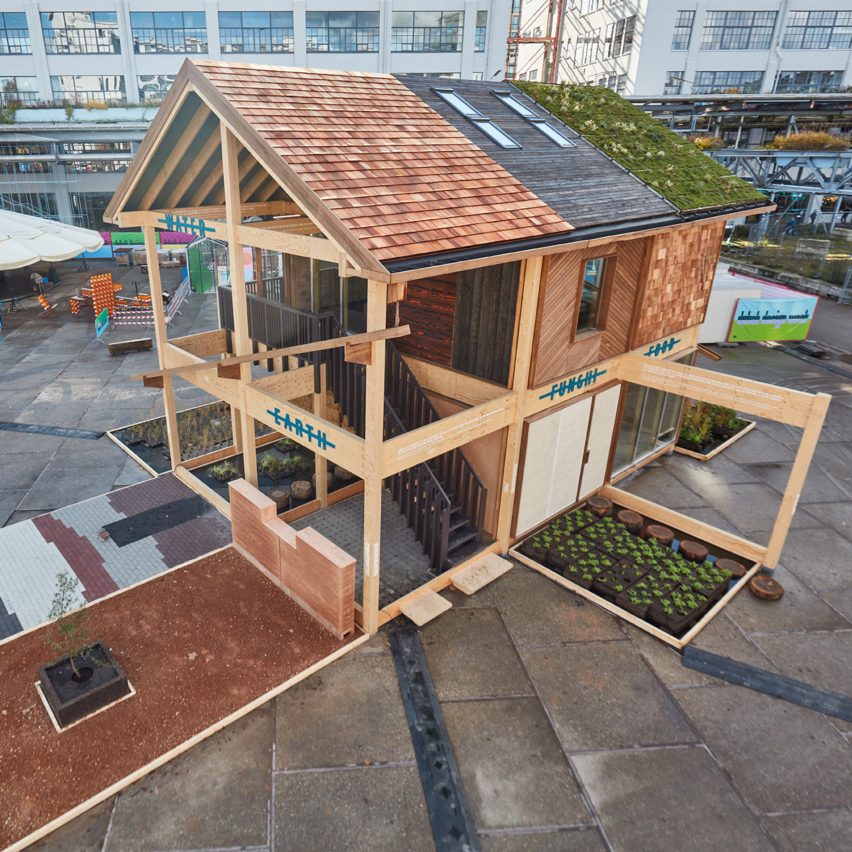
Eco-design studio Biobased Creations has built a showhome almost entirely from biomaterials including wood, mycelium, seaweed, straw and vegetable fibres as well as earth and sewage.
Unveiled at Dutch Design Week in Eindhoven this week, the house showcases 100 different plant-based or natural materials that are either commercially available already or coming to market soon.
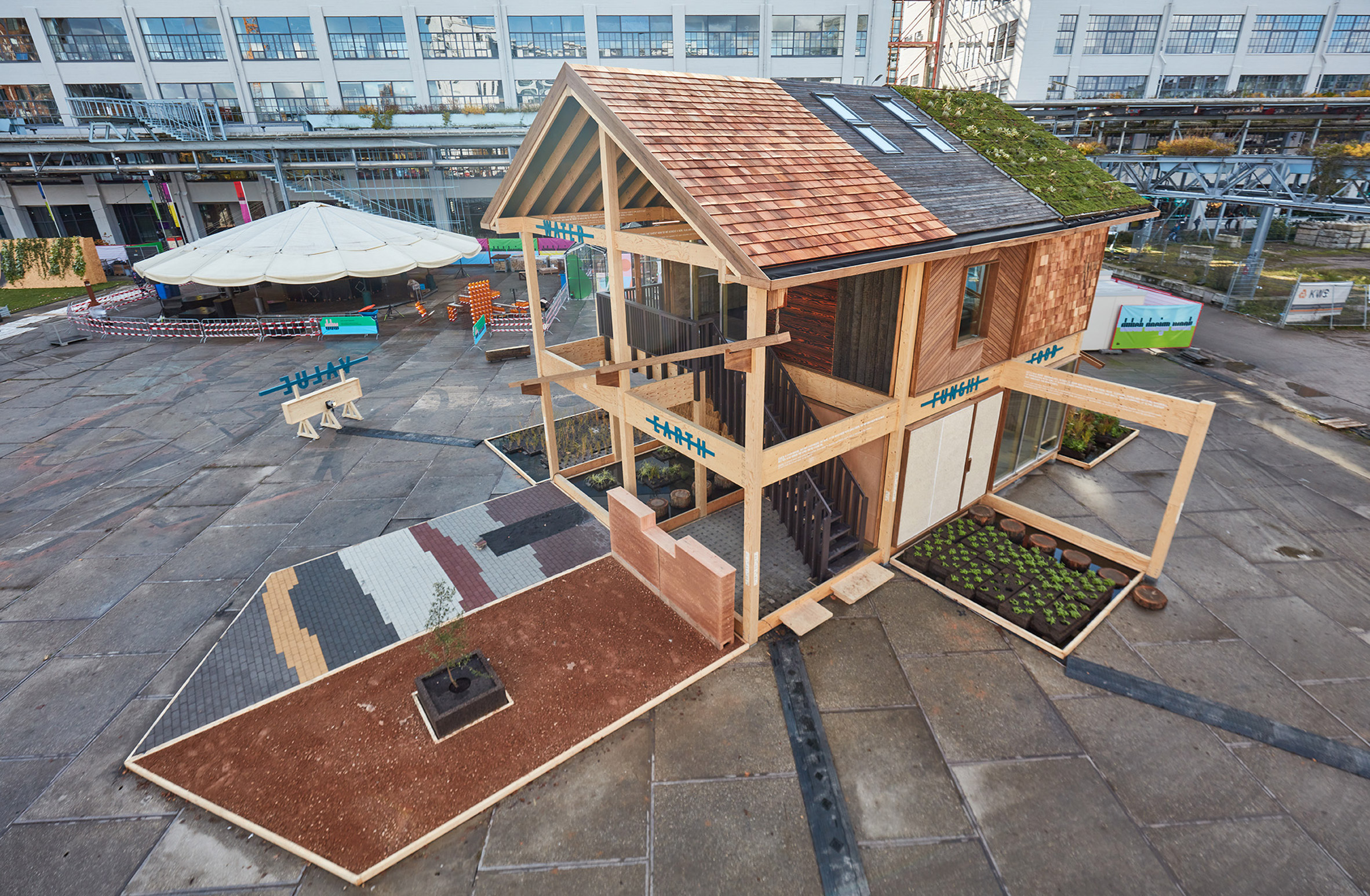 The house is built from 100 different natural materials
The house is built from 100 different natural materials
The only non-bio materials in the timber-framed house are metal screw fixings and glass windows.
"We used 100 bio-based materials because we wanted to show what is possible," explained Biobased Creations co-founder Lucas De Man. "It's an exhibition in the shape of a house."
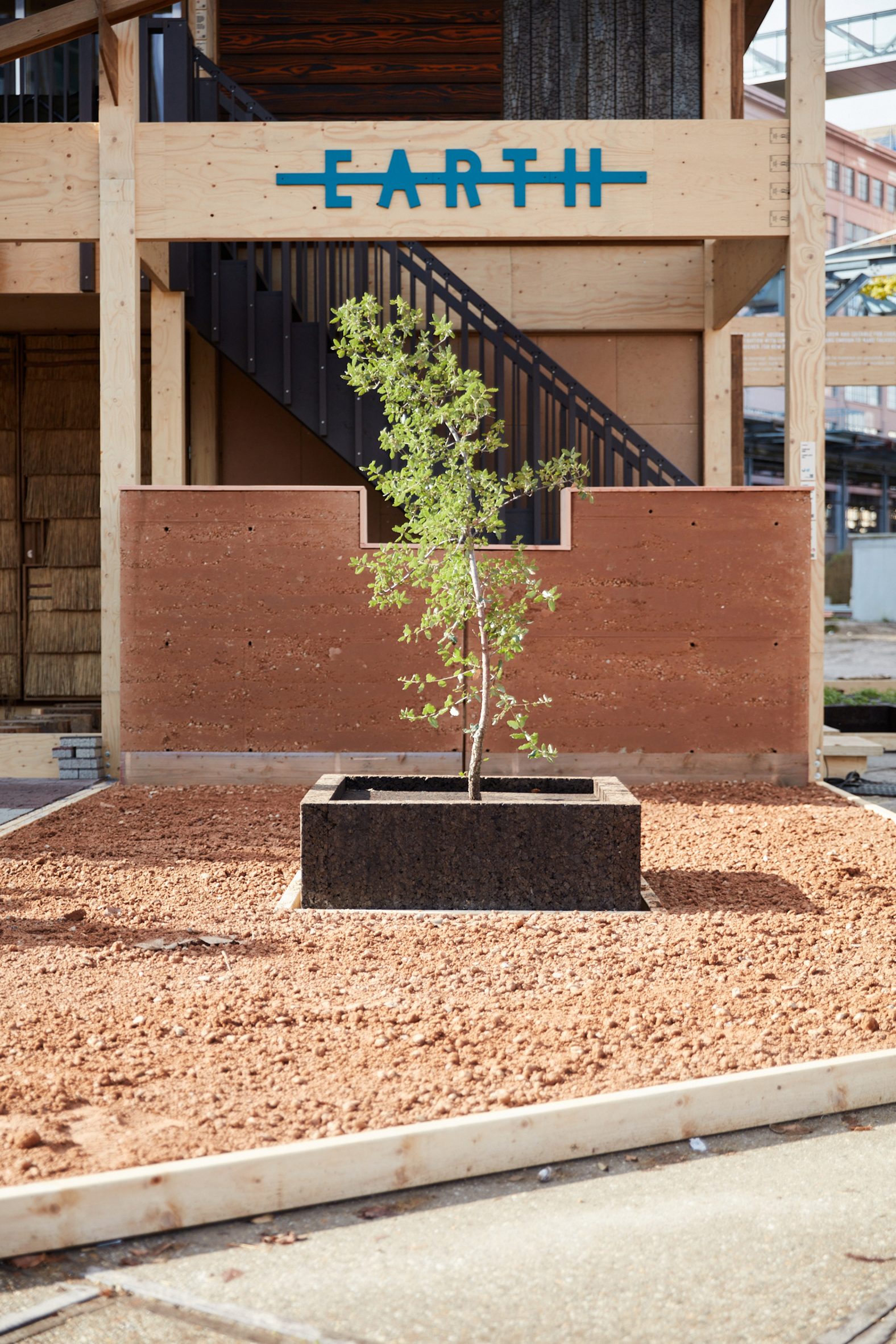 It showcases 100 different biomaterials, including earth, plants and fungi
It showcases 100 different biomaterials, including earth, plants and fungi
The project is called The Exploded View Beyond Building, although Dutch Design Week calls it The Embassy of Circular and Biobased Building.
The designers' aim is to show how eco-materials can be used in the construction of ordinary homes. All the materials used are listed on the projects' website.
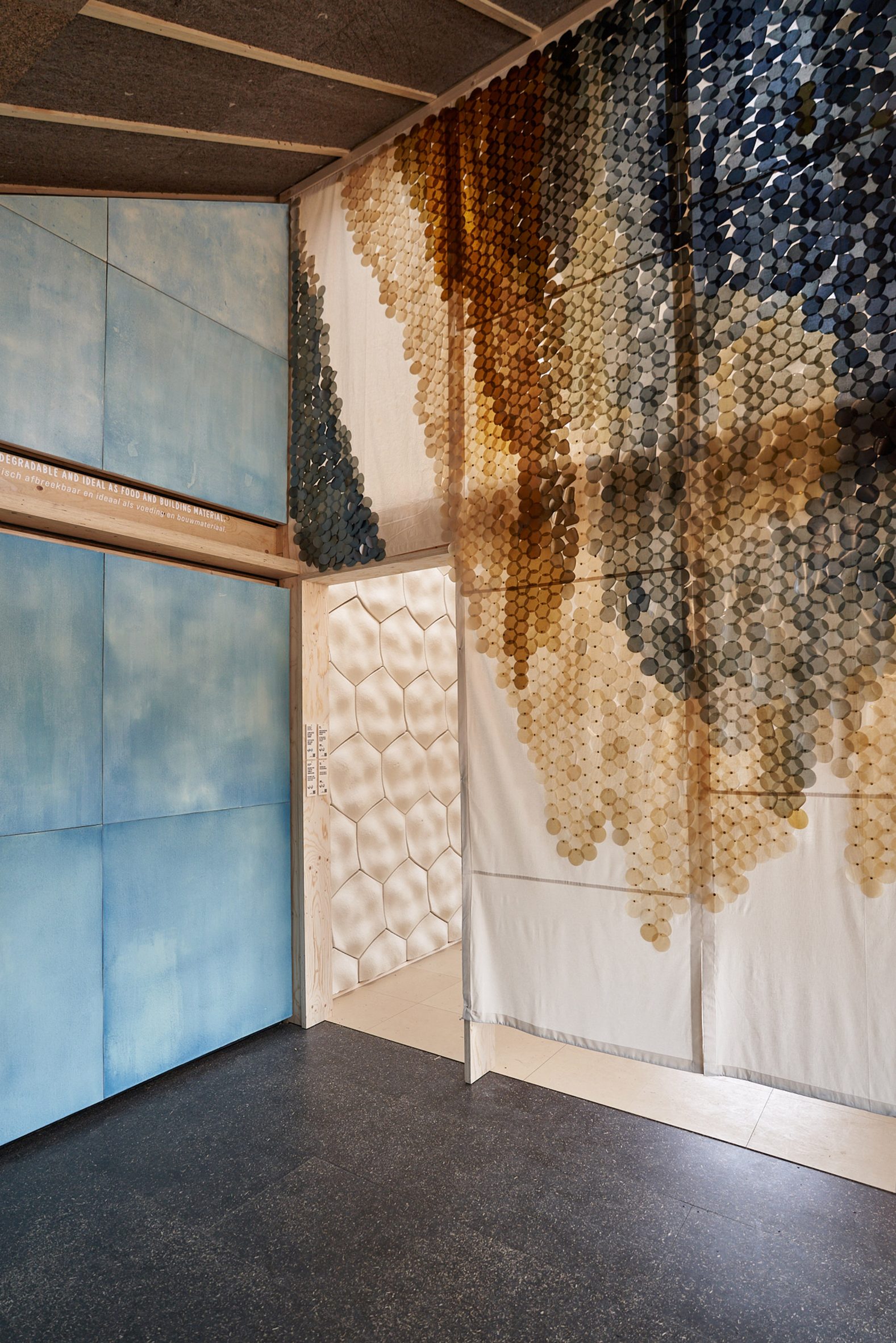 Materials include lime plaster coloured with algae and an algae textile screen
Materials include lime plaster coloured with algae and an algae textile screen
The house, which features a modular design, was mostly built in a factory. It has a layout based on a standard grid so it could become a template for a variety of different house designs.
"If we want to build a million houses here in Holland in the next 10 years, then the design has to be scalable," said De Man. "So it has to come from the factory and it has to be sustainable."
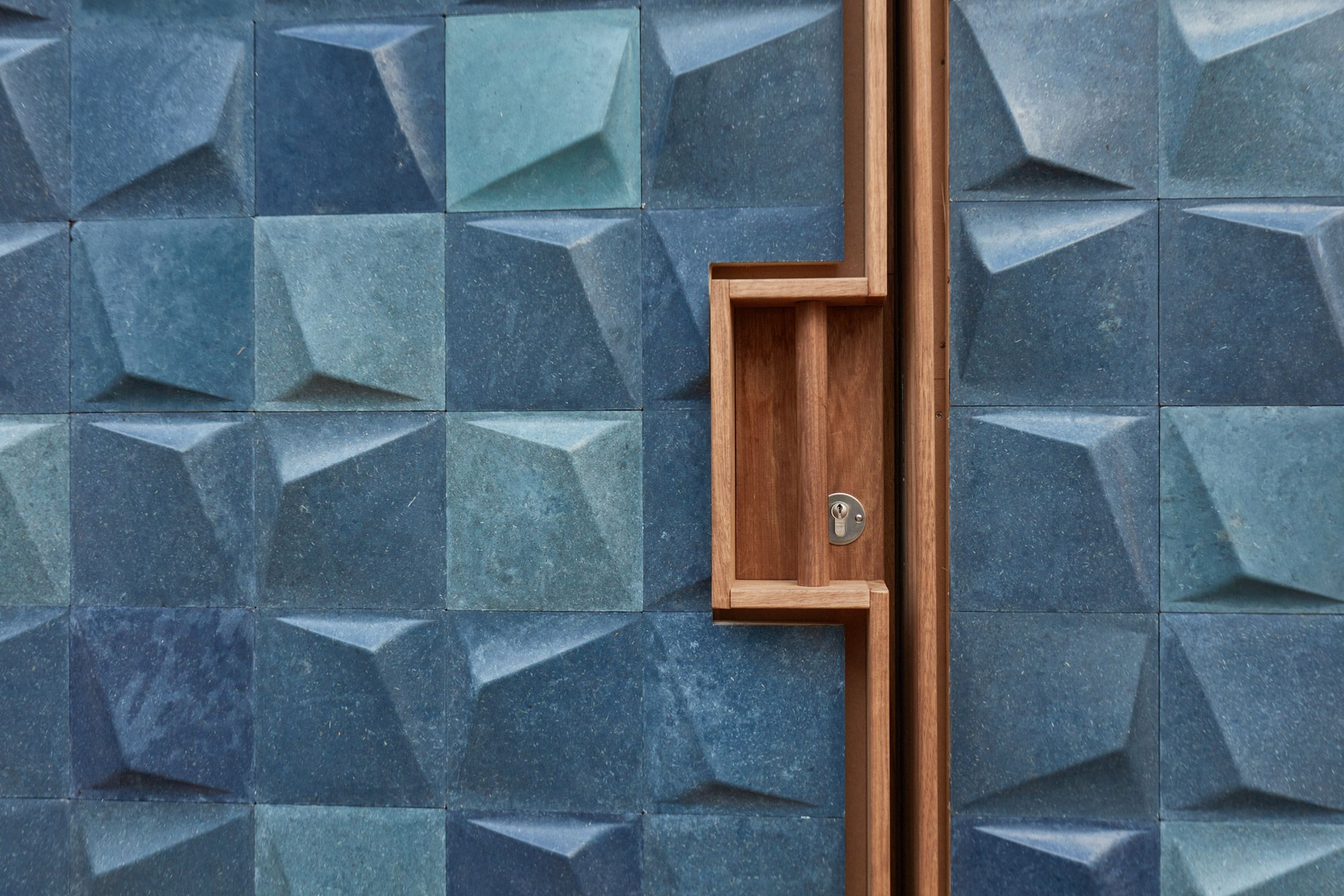 The bathroom exterior tiles are 3D printed from sewage sludge and algae
The bathroom exterior tiles are 3D printed from sewage sludge and algae
"Some people think it's too expensive to be modular and sustainable, but it's actually cheaper," he told Dezeen. "Non-sustainable modular is way more expensive."
The building, which has been erected at Eindhoven's Strijp-S district for the duration of Dutch Design Week, is also designed to be circular.
The structural timber frame is demountable so the house could be relocated or recycled in the future.
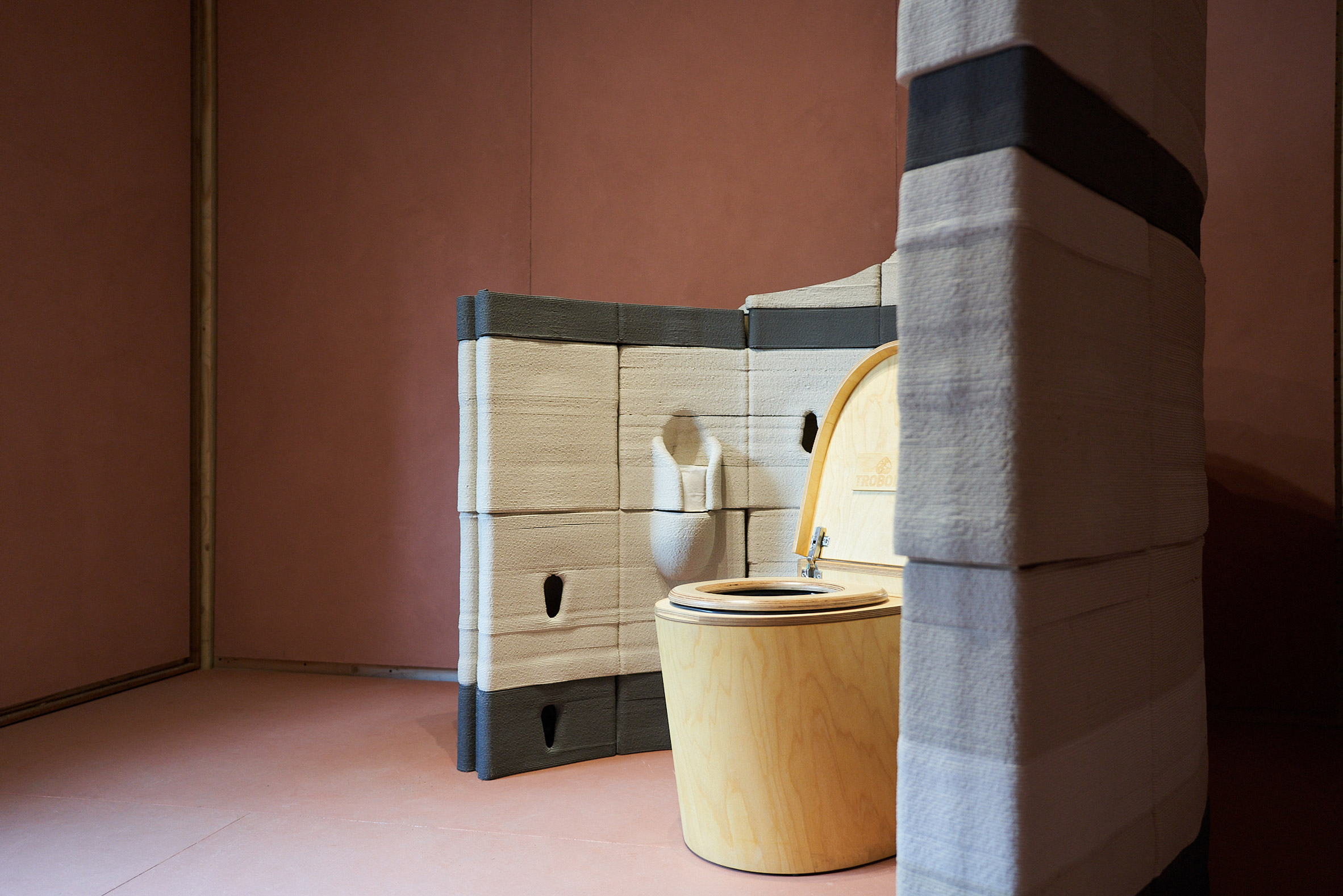 The toilet is framed by a 3D printed wall of filtered sewage residue
The toilet is framed by a 3D printed wall of filtered sewage residue
Biomaterials provide surfaces both inside and outside the house.
They cover walls, floors and ceilings, and are also used for furnishings including tableware and bedding.
[ 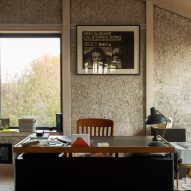
](https://www.dezeen.com/2021/07/17/ten-tactile-biomaterials-interiors-lookbook/)
These materials are presented in different categories relating to their material properties.
The bathroom features materials made from waste, with examples including blue wall tiles made from sewage and algae, and a compost toilet framed by a wall of 3D-printed sewage sludge.
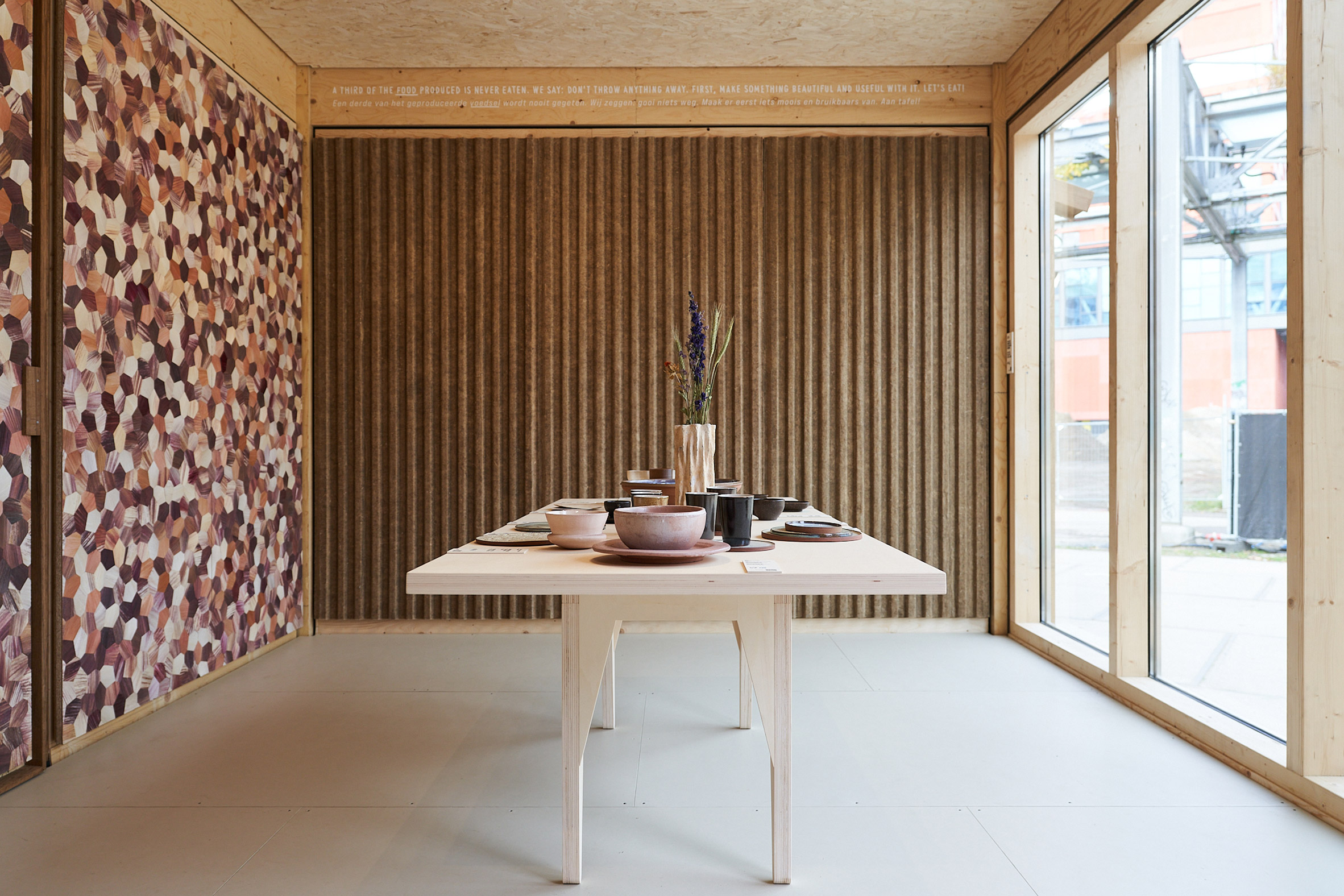 Tableware is made from food products including eggs and oyster shells
Tableware is made from food products including eggs and oyster shells
The kitchen showcases materials made from food and plants and includes tableware made from plants and food waste including plates made from eggshells and beakers from 3D-printed seaweed.
The ceiling is a material made from flowers, the walls are lined with grass and the door is clad in Totomoxtle, a wood veneer that promotes biodiversity because it is made from heirloom corn species.
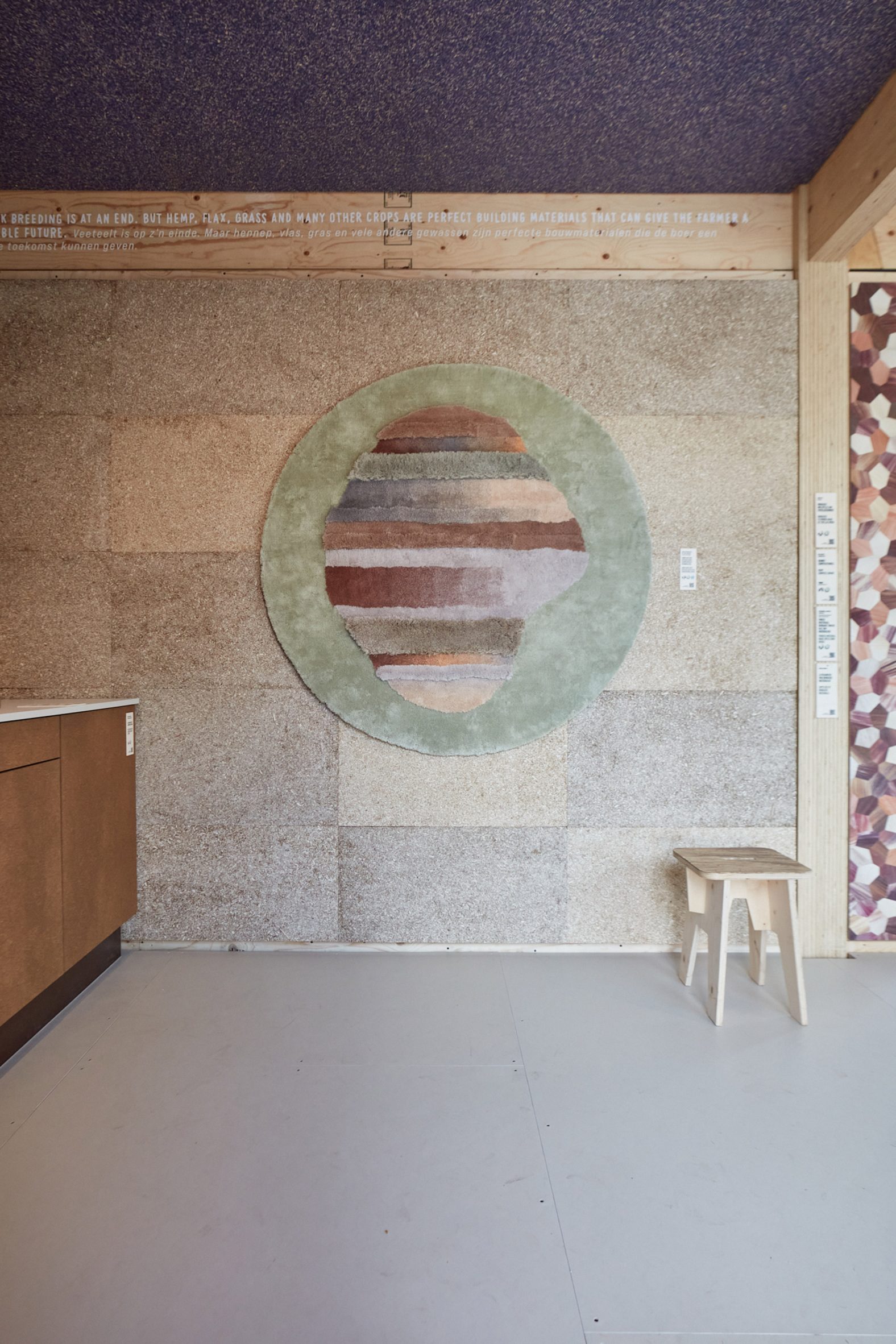 Linen coloured with waste from the metal industry is hung on the wall in the kitchen
Linen coloured with waste from the metal industry is hung on the wall in the kitchen
Upstairs, elements on display include insulation made from reeds, seaweed wall tiles, acoustic wall panelling made from bioplastic and a bed made from natural rubber and linen.
There's also a whole room dedicated to products derived from bacteria and fungus. Mycelium is used to create wall tiles, insulation and a composite flooring.
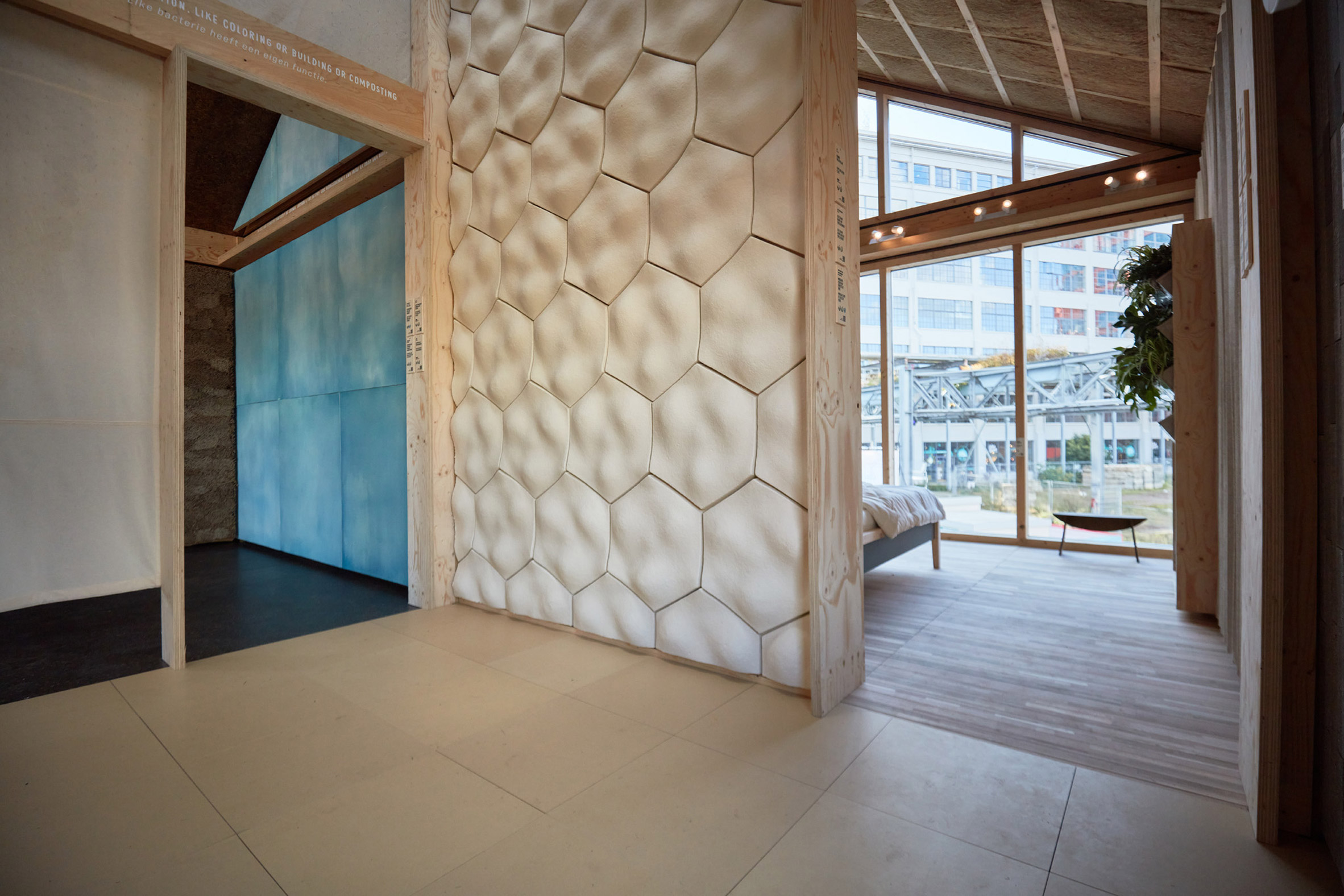 A wall of mycelium tiles is fire-retardant and water-resistant
A wall of mycelium tiles is fire-retardant and water-resistant
This material is one that both De Man and Pascal Leboucq, lead designer for Biobased Creations, were already familiar with. The pair previously worked on The Growing Pavilion, a mycelium structure presented at Dutch Design Week in 2019.
"We're going to solve a lot of problems by reinventing bacteria," said De Man. "In Holland, they are now making bacteria that can eat plastic and give back oxygen."
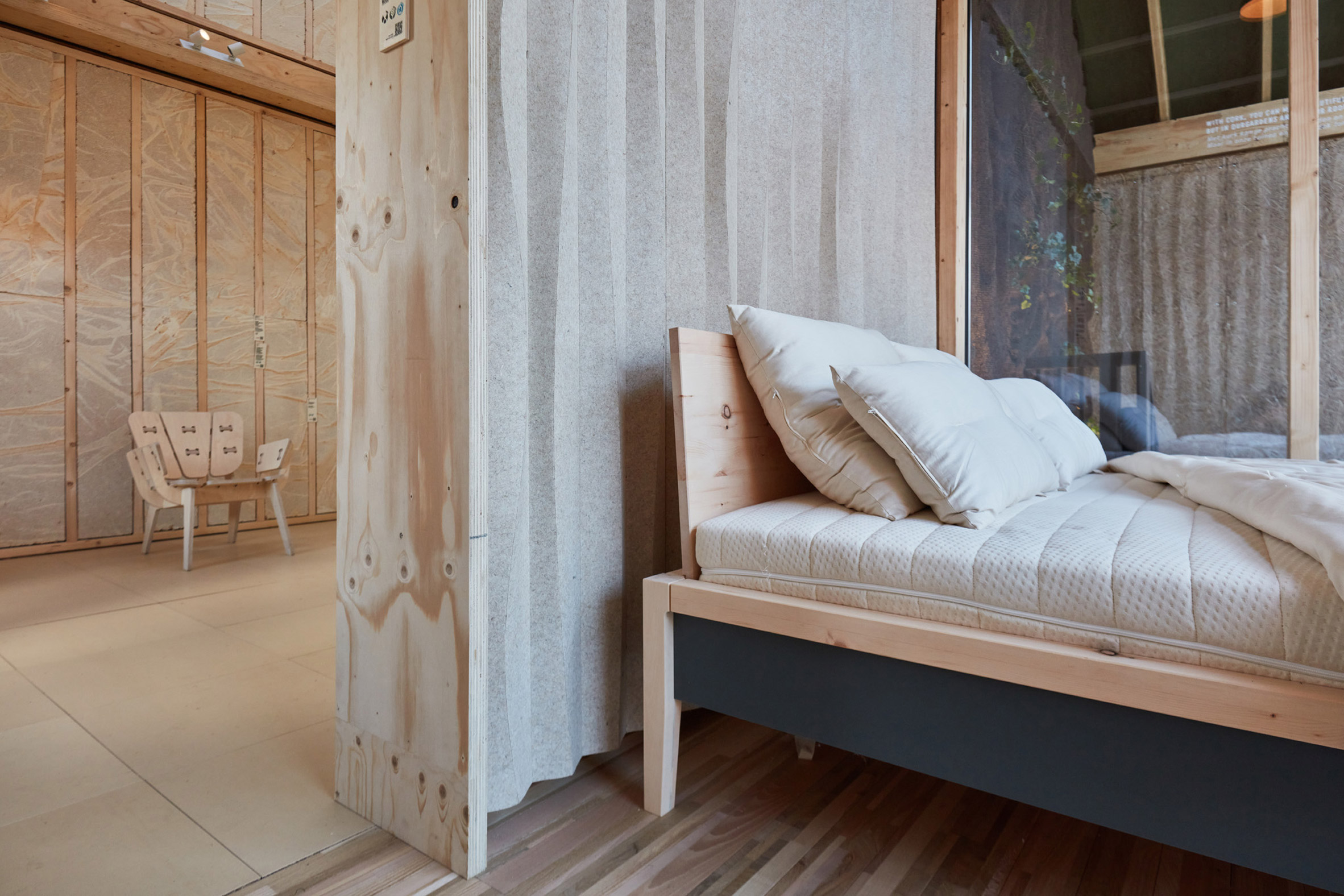 The bed combines a natural rubber mattress with linen fabric
The bed combines a natural rubber mattress with linen fabric
An air filtration system integrates plants and nutshells while rainwater is harvested and reused. The house also features six different roof types, including two types of green roof and paving that absorbs rainwater.
De Man hopes the project will show that biomaterials are a viable option for new housing developments.
"When we built The Growing Pavilion two years ago, a lot of people said it was too futuristic. This time we've created a house that is realistic and scaleable."
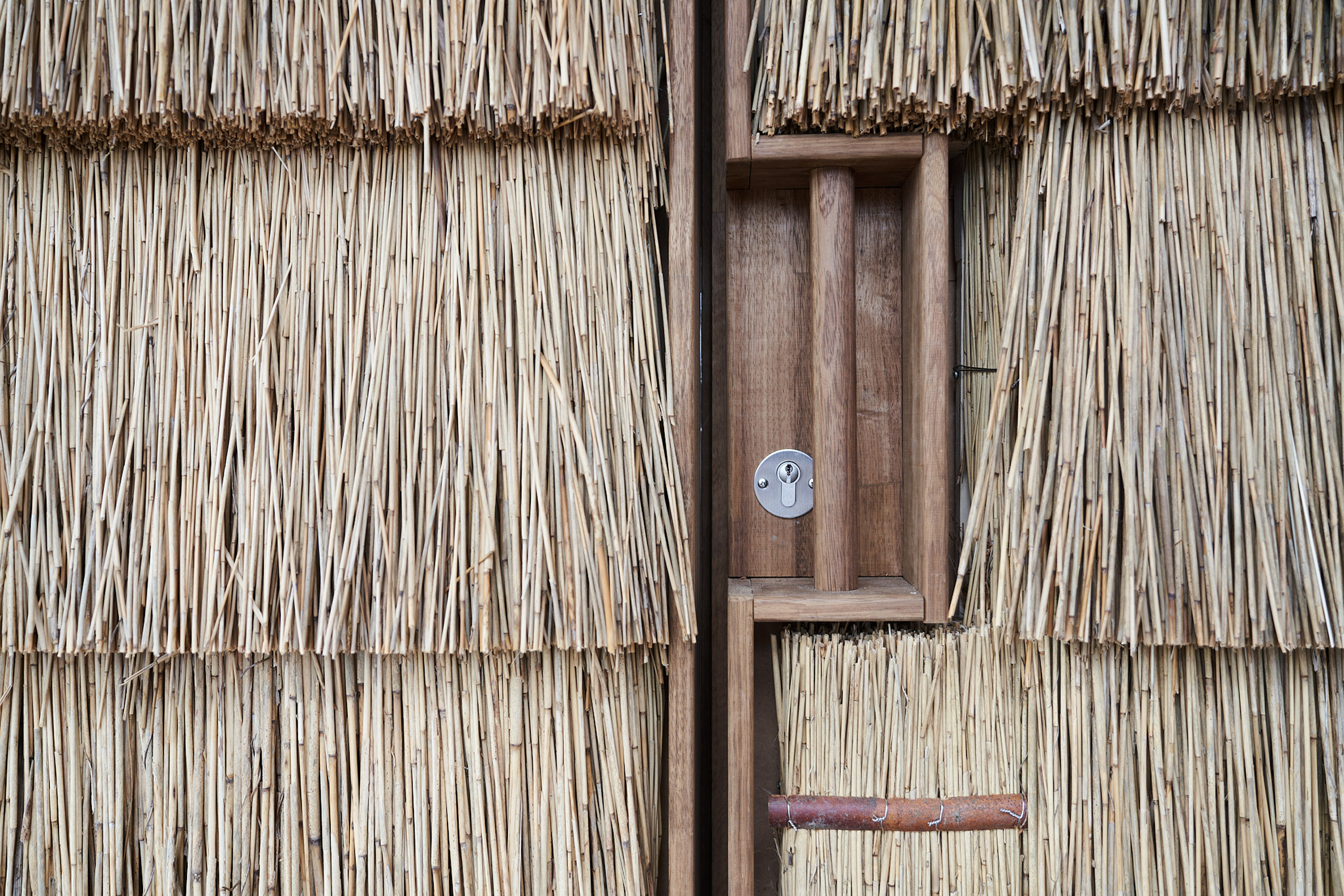 Straw cladding is used on the outside of the house
Straw cladding is used on the outside of the house
The house is on show for the duration of Dutch Design Week. After that it will be demounted and reassembled at the Floriade Expo, a horticultural exhibition taking place in 2022.
Dutch Design Week runs from 16 to 24 October 2021 at venues across Eindhoven. See Dezeen Events Guide for an up-to-date list of architecture and design events taking place around the world.
Photography is by Oscar Vinck and Jeroenvander Wielen.
The post House built from 100 different plant-based materials unveiled at Dutch Design Week appeared first on Dezeen.
#residential #all #architecture #videos #wood #dutchdesignweek #straw #houses #seaweed #architecturevideos #mycelium #sustainablearchitecture #biomaterials
Fantastic Fungi
Fantastic Fungi video on Odysee
Paul Staments is the main protagonist of this video in this wonderfully visual documentary, known from the TED talk "6 ways mushrooms can save the world".
This documentary elaborates on many of these ideas, and also on new findings. This documentary also contains interview with many others, experts and amateurs/enthusiasts.
Fungi are the link between many creatures literally (forests) but also symbolically (death and beginning). They can be used as food, medicine for body (helping in the cure for several cancers) and mind (healing depression in a hand full of sessions) and are the key to life on earth. And can also be used as packaging among other applications.
I have learned a lot from Paul Staments and he also seems a fun guy ;)
#mushroom #mycelium #food #medicine #psylocibin #wisdom #healing #carbon #death
Picture from Pexels
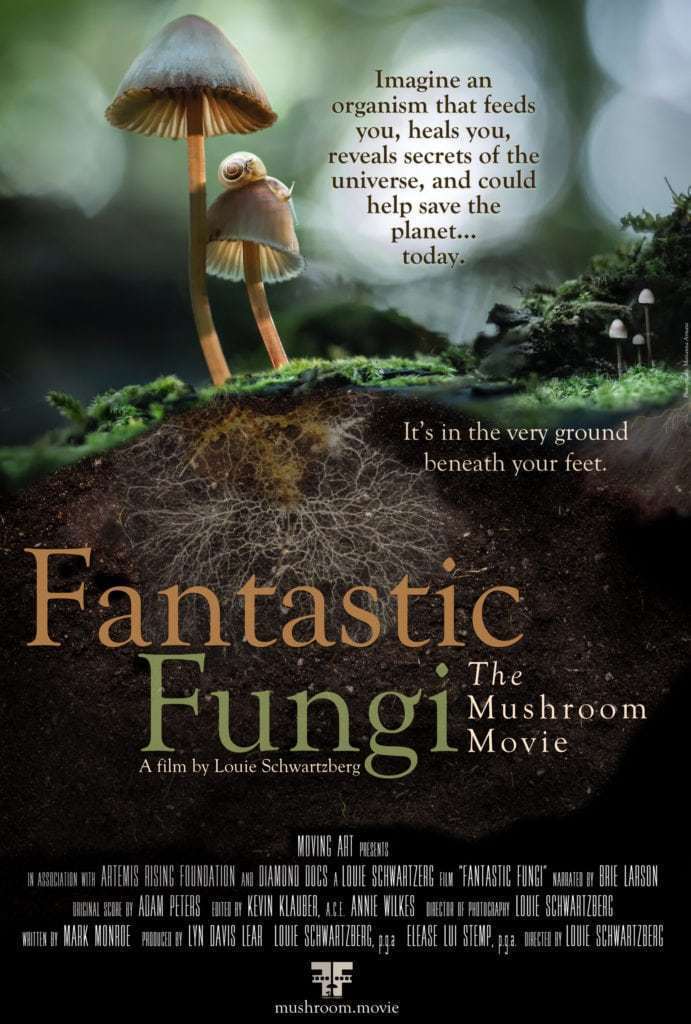
Imagine an organism that feeds you, heals you, reveals
secrets of the universe and could help save the planet.
Now imagine that it’s in the ground beneath your feet…
An artistically-shot, scientifically-sound, life-affirming film about mycelium: the incredible, intelligent network under our feet that has the proven ability to restore our ecosystem, repair our health, and resurrect our symbiotic relationship to nature. Fantastic Fungi aspires to be an educational, inspirational, and ultimately critical film that explores the uses and benefits of fungi in three critical areas.
First, we uncover the research that shows mycelium as a viable alternative to western pharmacology, including treatment for breast cancer, Alzheimer’s disease, and PTSD. Second, we reveal studies that point to mycelium as a solution to our gravest environmental challenges, such as toxic oil spills and colony collapse disorder. Finally, we marvel at mycelium’s proven benefit on shifting consciousness and aiding in deep personal transformation. The research, discoveries, and anecdotal evidence we’ve gathered is astounding, particularly when shared through Louie’s visual storytelling.
An all-star team of artists, scientists, doctors and explorers are joining forces to create a mind-bending, life-affirming film about the mushroom and its mysterious root-like structure: mycelium. What they reveal will blow your mind, and possibly save the planet.
Teaser -> https://vimeo.com/134251951
Preview -> https://vimeo.com/278244352
Sneak Peek -> https://vimeo.com/153530427
#FantasticFungi #documentary #film #mycology #mycelium #fungi #mushrooms #mushroom #ecology #sustainability #human #survival #health #life #inspiration #consciousness #paradigm #shift #life-affirming #nature #environment #EugeniaBone #TonyHead #AndrewWeil #MichaelPollan #TraddCotter #SuzanneSimard #JayHarman #PaulStamets #LouieSchwartzberg #mushroommovie #docu-films